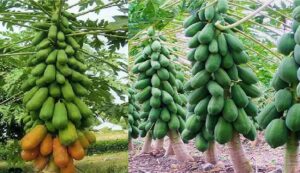Papaya cultivation: Follow these tips for papaya cultivation
Papaya cultivation: The majority of farmers in the nation are experimenting with non-traditional farming in an attempt to augment their conventional cash streams, and they are finding success in it. Most farmers would rather plant fruits in order to make more money in less time and money. Papaya is another one of these crops that is widely farmed in India. Boron (B) is a crucial micronutrient for papaya growth since it is necessary for the formation of cell walls, membrane integrity, and reproduction. A papaya plant lacking in boiron may show up in a number of ways that are detrimental to the plant’s overall health and fruit-producing capacity, including as

These are the primary signs of a boron shortage in papaya farming.
1. Deformed leaves: One of the first signs of a papaya boron shortage is the distortion of the young leaves. The leaves may grow brittle, curl up or down, and thicken along the veins. Additionally, there may be a noticeable reduction in leaf size, which makes the leaves seem rigid and distorted.
2. Chlorosis: A boron shortage results in interveinal chlorosis, or yellowing between the veins, in papaya leaves. As a result, leaves look mottled or yellow, particularly the younger leaves.
3. Reduced growth: Affected plants develop more slowly as a result of decreased cell division and elongation. The plant may grow less tall and vigorously overall if the tips of its shoots get necrotic and die back.
4. Poor fruit and blossom growth: Papayas with low levels of boron develop poorly. Early flower withering may lead to a significant decrease in fruit yield. Furthermore, fruits that do grow might be less marketable due to interior corkiness, fractures, or other defects.
5. Main stem cracking: Papaya plants with boron deficiencies often exhibit main stem splitting or cracking, which may be connected to gum leaking. This may weaken the plant’s structure and make it more vulnerable to disease and insect infestation.
How may a lack of boron be treated?
Papaya boron shortage management calls for a well-rounded approach that incorporates foliar and soil treatments in addition to routine soil and water quality monitoring.
1. Soil amendment: Boron shortage in papaya may be treated by adding boron-containing fertilizers to the soil, such as Solubor (sodium pentaborate) or Borax (sodium borate). An adequate quantity of borax per acre is typically 1-2 kg, depending on the kind of soil and degree of deficiency. Use cautious when using large doses since boron poisoning may occur.
2. Foliar Spray: Applying boron to papaya trees via the foliage is a quick and effective way to alleviate the symptoms of a deficit. Leaves may be sprayed with a solution containing 0.1-0.2% Solubor or 0.2 to 0.3% Borax throughout the vegetative and reproductive phases. Frequent spraying may be necessary to keep boron levels at appropriate levels, particularly during high-demand times like blooming and fruiting.
3. Soil Testing and Fertilizer Management: To determine boron levels and adjust fertilizer application as necessary, it’s essential to conduct routine soil testing. Because soils with a pH of more than 7.0 (alkaline) have lower boron availability, increasing the pH of the soil with sulfur or organic matter may boost boron absorption.
4. Including Organic Matter: More organic matter in the soil increases boron availability. Compost and well-rotted manure not only provide boron but also improve soil structure, water-holding ability, and nutrient retention—all of which aid in the more efficient uptake of nutrients by papaya plants.
5. Water Management: The availability of boron may be restricted by high pH or carbonate irrigation water. Ensuring appropriate water management practices, such as utilizing water with a balanced mineral composition and avoiding waterlogging or drought stress, may help with boron absorption. Moreover, drip irrigation helps to keep the soil at the proper moisture content for absorbing nutrients.
6. Balanced Fertilization: Boron shortage is often linked to deficiencies in other minerals, particularly those of calcium and potassium. In addition to key nutrients like nitrogen, phosphorus, and potassium, a balanced fertilizer program including micronutrients should be maintained to support overall plant health and development.
By putting these management strategies into practice and avoiding and minimizing the effects of boron deficit, papaya producers may assure healthy plant growth, optimal flower and fruit development, and higher output. Maintaining appropriate boron levels in papaya cultivars calls both timely intervention as well as routine monitoring.

